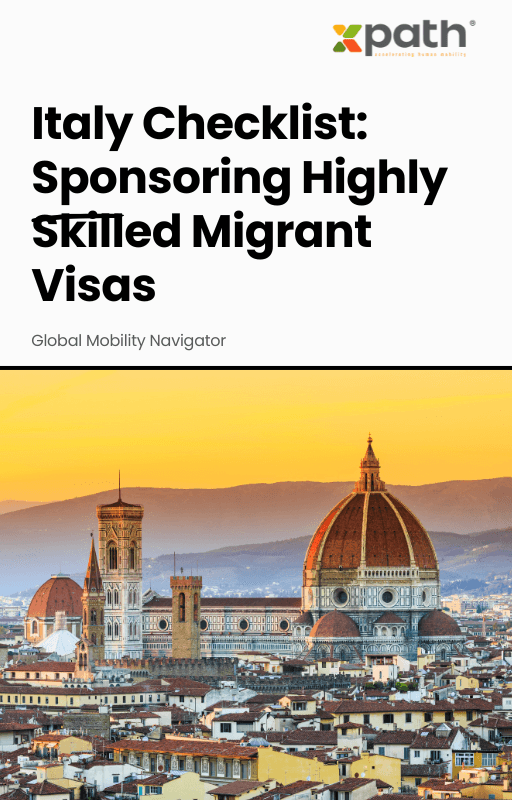Italy Checklist: Sponsoring Highly Skilled Migrant Visas
Grab a copy of a guide to international employee relocation
View E-bookManaging a global workforce is no longer a privilege reserved for multinational corporations. Small and medium-sized enterprises (SMEs) are increasingly expanding their operations across borders, necessitating efficient global mobility strategies. However, traditional methods of managing international assignments are proving inadequate in the face of complex compliance requirements, diverse cultural landscapes, and the need for real-time data. This is where HR Global Mobility Technology steps in, transforming global mobility from a luxury into a necessity.
HR Global Mobility Technology encompasses digital tools and platforms designed to streamline the management of international employee assignments. These technologies automate various aspects of global mobility, including visa processing, tax compliance, relocation logistics, and cultural training. By integrating these functions into a centralized system, organizations can enhance efficiency, reduce errors, and improve the overall employee experience.
The digital transformation has significantly impacted global mobility. Previously, managing international assignments involved manual processes, extensive paperwork, and coordination across multiple departments. Today, advanced technologies like artificial intelligence (AI), machine learning, and cloud computing have revolutionized these processes. For instance, AI-driven platforms can predict potential compliance issues, while cloud-based systems enable real-time tracking of employee movements and assignment statuses .
Small HR teams often grapple with limited resources, making it challenging to manage complex global assignments effectively. Manual processes are time-consuming and prone to errors, leading to compliance risks and employee dissatisfaction. Moreover, staying updated with ever-changing immigration laws and tax regulations across different countries adds another layer of complexity.
Embracing HR Global Mobility Technology allows small HR teams to automate routine tasks, such as document verification, compliance checks, and communication with stakeholders. This shift not only reduces administrative burdens but also minimizes errors and ensures timely execution of assignments. For example, platforms like Deel offer streamlined payroll capabilities, enabling fast, automated payments across multiple currencies with low transaction costs .
Compliance with international labor laws and tax regulations is critical in global mobility. HR Global Mobility Technology provides automated compliance checks, ensuring that all legal requirements are met before, during, and after an assignment. Additionally, these platforms offer real-time tracking of assignments, allowing HR teams to monitor progress and address issues promptly.
A positive employee experience is vital for the success of international assignments. Integrated tools within HR Global Mobility Technology platforms offer employees access to resources such as cultural training modules, relocation assistance, and communication channels with HR representatives. These features help employees adapt to new environments more smoothly, increasing their satisfaction and productivity .
mercer.com
Access to real-time data is crucial for making informed decisions in global mobility. HR Global Mobility Technology provides dashboards and analytics that offer insights into assignment costs, compliance statuses, and employee performance. These insights enable HR teams to make proactive decisions, optimize resource allocation, and identify areas for improvement.
Centralized platforms consolidate all aspects of global mobility, reducing the need for multiple vendors and systems. This consolidation leads to cost savings through economies of scale and streamlined processes. Moreover, centralized data management minimizes the risk of errors and ensures consistency across all assignments .
The global business landscape is continually evolving, with factors such as geopolitical shifts, economic fluctuations, and pandemics impacting mobility. HR Global Mobility Technology offers scalability, allowing organizations to adjust their mobility programs in response to changing circumstances. Whether expanding into new markets or adapting to remote work trends, these technologies provide the flexibility needed to stay competitive .
air-inc.com
Selecting the appropriate technology is critical for the success of a global mobility strategy. Organizations should consider factors such as ease of integration with existing systems, user-friendliness, compliance capabilities, and vendor support. Engaging stakeholders from HR, IT, and finance departments in the selection process ensures that the chosen solution aligns with organizational goals and requirements.
What is HR Global Mobility Technology?
It refers to digital tools and platforms that streamline the management of international employee assignments, including compliance, relocation, and cultural integration.
Why is HR Global Mobility Technology essential for small HR teams?
It automates routine tasks, reduces administrative burdens, and ensures compliance, enabling small HR teams to manage complex global assignments efficiently.
How does HR Global Mobility Technology enhance employee experience?
By providing resources such as cultural training, relocation assistance, and communication tools, it helps employees adapt to new environments smoothly.
What are the cost benefits of using HR Global Mobility Technology?
Centralized platforms reduce the need for multiple vendors, streamline processes, and minimize errors, leading to significant cost savings.
How does HR Global Mobility Technology help in compliance management?
It offers automated compliance checks and real-time tracking, ensuring adherence to international labor laws and tax regulations.
What should organizations consider when choosing HR Global Mobility Technology?
Factors include integration capabilities, user-friendliness, compliance features, scalability, and vendor support.
In the modern business environment, HR Global Mobility Technology is no longer a luxury but a necessity. It empowers HR teams to manage complex international assignments efficiently, enhances employee experience, and provides a competitive edge. By embracing these technologies, organizations can future-proof their global mobility strategies, ensuring adaptability and success in an ever-changing world.
Ready to transform your mobility program? Explore xpath.global’s solutions.

Italy Checklist: Sponsoring Highly Skilled Migrant Visas
Grab a copy of a guide to international employee relocation
View E-book